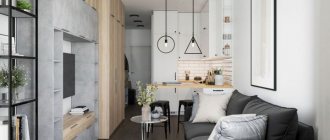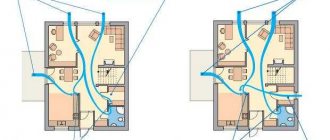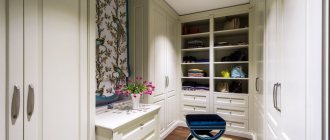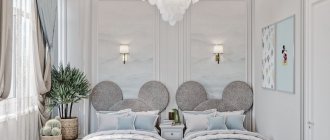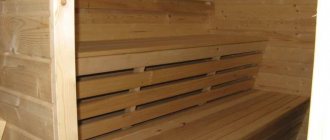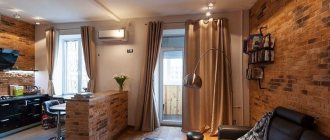Until recently, there was no separate room for storing things in Russian apartments. Changing living standards and the development of the consumer market have led to the fact that such premises have become a necessary element of modern residential planning. Like these ones dressing rooms, design projects, photos which are presented in the article, can be done in your apartments.
Today, every woman dreams of having a special place in her apartment to store her favorite outfits and fashion accessories.
Many men tend to consider such a room in the house an unnecessary luxury, especially if the apartment is small in size. But in fact, functional arrangement of living space helps to make housing more comfortable and spacious. If you wish, you can create a dressing room in a small apartment.
What is a dressing room?
A dressing room is a specially equipped room that provides space for proper storage of clothes. Shelving structures and hangers of various shapes and sizes are usually installed in it.
Such a room has lighting and doors to protect things from direct sunlight and dust. You can place all your personal items and shoes on different shelves and hangers. Using such an equipped space will help to better store things and save time on finding a suitable set of clothes for work or leisure.
Organization of dressing room space
Regardless of which living space the dressing room will be in (house, apartment), its vertical space is organized in the same way: the middle part (the largest), upper and lower.
The upper part is usually convenient for storing bedding (blankets, pillows), seasonal clothes in covers and vacuum bags. The location near the ceiling suggests that there will be a small stepladder or folding ladder in the dressing room.
Then the middle part will be occupied by clothes that are needed every day or used quite often, and the lower zone will be space for shoes and shoe boxes.
Structurally, the middle part consists of rods for hangers at a height of no more than 1.9-2 m and a length of up to 1.2 m. For longer lengths, intermediate fastenings are used. Here you also need short shelves (up to 90 cm) for sweaters, blouses, jeans, hats and scarves. The shelves are suitable both open and closed.
If there is sufficient space, it is possible to install cabinets with shirt drawers, racks for trousers and ties.
The part of the dressing room closer to the floor is, first of all, a place for shoes and shoe accessories. For this, shelves 30-40 cm wide are sufficient. Any housewife usually finds a place for out-of-season shoes and those that will be needed today or tomorrow.
The best entry option for a dressing room is a sliding door; for small areas of the home, a curtain on the curtain.
The depth of the space for storing clothes is usually 60-70 cm (from the wall), the passages between hangers, cabinets, shelves - from 70-75 cm.
History of appearance
A separate room for storing things is already found in houses of ancient eras. Egyptian pharaohs and patricians of Rome had such places in their luxurious homes.
In medieval Europe, the nobility also preferred to store their outfits in separate rooms designated for this purpose. A large change of clothes was available in different eras only to the privileged strata of society, whose home was palaces and castles.
The development of industrial production, which also influenced the sewing of clothes for mass consumption, led to an increase in purchases of clothing production by different categories of consumers. In the 20th century, dressing rooms in the Old and New Worlds began to appear in actresses and theater divas. The development of the fashion industry has led to an increase in demand for fashionable clothing not only among women, but also among men. At the end of the 20th century, the clothing industry presented a wide range of different styles for every season, for both adults and children.
Due to the growing number of things in the individual wardrobe of a modern person, the need to organize a special place for storing them has become an urgent necessity. Today, such a place can be organized even in a small apartment by developing an individual design for a dressing room.
Wardrobe systems rating
Among the huge number of manufacturers, there are several that have been on the market for a long time and offer only the best quality furniture. Nowadays, the best wardrobe storage systems are produced by the following companies:
- Ikea;
- Aristo;
- Elf;
- Leroy Merlin;
- Commander;
- Uno;
- Closetmaid;
- Stilos.
Clothes storage room with natural light
Site selection and project development
The most affordable way to create a dressing room in a small house is to refurbish the pantry. Arranging this space will help bring more order to the living space and make the pantry more functional. But if it is not in the apartment, then you can zone the space of one of the rooms.
Advice! Before you start arranging a place for rational storage of clothes in the pantry, you should develop a design project. This will help to avoid mistakes and waste of money at the practical stages of implementation.
Before you start creating a dressing room, you need to allocate a place for it. In new houses with improved layouts today, designers specifically set aside such space for arranging storage. This is not provided for in old-type apartments. But there is a way out: you just need to choose the right place. It could be:
- pantry;
- a place in the bedroom that will need to be arranged for storing clothes;
- special modular cabinet.
If the apartment has a storage room, then it can be converted into a dressing room. To do this you will need:
- drywall;
- metal racks;
- hung the desired design;
- LED lights;
- acrylic paint for walls and ceilings or wallpaper;
- furniture fittings.
Advice! Before starting work, you need to determine exactly how many things the space will be equipped with. This will help you rationally plan your renovation budget.
When arranging a pantry, you will need to provide lighting and consider ventilation for proper storage of clothes. In general, this method will be the least expensive, since the room already has doors and walls. You just need to select functional shelving and make cosmetic repairs to the pantry itself. To organize the space functionally, you will need shelves and drawers. You can install a large mirror on the back of the door if the storage area allows.
Arranging a place for proper storage of things will require large investments. You can allocate part of the space in the bedroom or hallway for a dressing room. When looking for a place, you need to provide a location that is convenient for all family members.
To organize the storage of outfits, partitions and redevelopment of the room will be required. This is quite expensive and troublesome. But in the end, the house will have an equipped place for proper storage of clothes of all family members.
To arrange a dressing room, you can also use a ready-made furniture module, which is purchased to order from a furniture company. Skilled apartment owners can independently assemble such a structure from MDF and furniture fittings. When developing a project, it is necessary to provide places for storing shoes and clothing of various types.
Arrangement of the storage room
A pantry allows you to create a dressing room at minimal cost. Before starting work, you need to empty the closet space of all things stored there and inspect it. Assessing the space will help you correctly purchase the necessary fittings and shelving structures.
You can make shelves for storing folded clothes from MDF or laminated chipboard.
If space allows, you should purchase hangers on which to place clothes on hangers.
The dressing room should have two zones. In one part of it, all things are stored in a vertical position. Hangers are installed here. At the bottom and top of such a compartment, you can provide shelves for storing shoes.
In the second compartment, clothes should be stored folded. To do this, you will have to install racks or make shelves. You will also need drawers. In addition to personal clothing, you can organize storage of pastel linen, towels, spare curtains, blankets and blankets here.
Do you need a dressing room in an apartment?
What is a dressing room? Is it necessary? Today, more and more often, many of us have a desire to acquire and arrange for ourselves a small room where we can conveniently store everyday things. And it doesn’t matter at all where the family lives: either in their own house or mansion, or in a 2-3 room apartment.
In fact, today people have stepped up a notch in terms of organizing and arranging their living space. Long gone are the days when clothes, shoes and boots were stored, hung or stood in closets, chests of drawers and hangers on the walls. And no one remembers the chests at all.
In the interior and design of modern housing, well-defined trends and directions are visible:
- the desire for space and a sense of space;
- free planning (and redevelopment) of residential premises;
- narrow functionality (purpose) of utility rooms.
By creating a dressing room in your apartment, you gain a lot of advantages:
- You no longer have to fill your apartment with various cabinets, chests of drawers, bedside tables, etc.
- If you plan it correctly, you can store not only your wardrobe in it, but also bed linen, all kinds of suitcases and bags, all of which takes up space.
- When stored properly, clothes wear out significantly less, which means their service life increases.
In modern apartments, a dressing room is already provided and the only question that remains is its arrangement. In old apartments, where such a room is not provided, there is always a room, part of which can be separated by a partition and made into your own small dressing room.
An example of zoning a room for clothes
Room zoning
When creating an equipped space for storing clothes, pastel accessories and home textiles, you can rationally divide the room into functional zones. To do this, the corner of the bedroom or hallway can be separated from the common space by partitions. It is not necessary to make a new room rectangular; arranging a corner would be an excellent option for a small apartment.
To create partitions separating the dressing room from the rest of the space, you will need:
- drywall;
- metal profiles;
- self-tapping screws
- electric drill
- primer;
- putty
- metal scissors.
First you need to make markings for attaching the profile and drywall. Places for attaching the metal profile are indicated on the walls and floor. Then, according to the dimensions of the future walls, plasterboard is cut and attached to the installed metal profile. The first step is to attach the structures to the floor, then to the walls, and then to the ceiling.
Metal parts and drywall are cut to appropriate sizes. To cut metal, a special tool is used - metal scissors, and drywall is cut with a hacksaw.
The finished metal frame is sheathed with plasterboard. When carrying out this work, you can put a soundproofing layer between the sheets and also install lighting. To do this, electrical wiring is laid at the sheathing stage.
Cellular storage system
The mesh wardrobe is versatile and compact. Multiple baskets and mesh shelves are its main feature.
The system is complemented by:
- shoe shelves;
- classic barbells;
- trouser fittings.
In most cases, such structures are divided into 3 main parts:
- hats are placed at the top;
- clothes and linen are stored in the middle one;
- at the bottom are shoes.
Owners, if they wish, can purchase other accessories that will increase its functionality. Each part of the system is independent of the others, so it can be removed or moved. All elements of the system are fixed to the wall using guides and brackets. Such elements give the system many advantages. One of them is that air is constantly supplied to the clothes, thanks to this the clothes are ventilated, there is no unpleasant, musty smell. In addition, you can calmly see what is in the basket. The absence of legs on the floor does not interfere with cleaning. Other benefits of this storage system include:
- availability of many accessories;
- unlimited modification possibilities;
- ease of assembly.
Practical advice
Instead of plasterboard, MDF or laminated chipboard is also used for cladding.
Once the partitions are installed, you can begin interior decoration. To do this, the seams of the sheets are puttied and primed to create a single space. The sheathing joints between the walls and ceiling are primed. A rough finish will ensure the strength and attractiveness of the interior space.
Finishing
In order for the new functional room to have an attractive exterior, it will need to be cleaned. It’s easier to cover plasterboard partitions with wallpaper. Various panels, natural wood or wall painting are also suitable. The latter finishing method is considered durable. Before painting, it is necessary to prime the walls.
It is necessary to take care of the floor covering. Tiles are suitable for such a room. But its installation is a labor-intensive process that requires professional training. If you want to save on floor finishing, you can use carpet or linoleum.
To protect things from dust, you need to install doors. The best option would be sliding structures that will not take up much space in the bedroom or hallway. From the outside, a large mirror is installed on them and lighting is supplied.
For ease of use of the new premises, lighting is installed in the extension. To do this, before installing racks, shelves and hanging fixtures, the fixtures must be fastened. For a dressing room, it is better to use LED spotlights.
Dressing room: size and design
Found the perfect location for your dream closet? All that remains is to prepare a high-quality project to successfully turn your fantasies into reality:
Wardrobe room: design secrets
What is the minimum width of a dressing room? Room sizes may vary. The width depends on the following factors:
- If the furniture is located along one wall, the width is calculated based on the depth of the cabinets, the width of the door and the passage. In this case, the width will be about 160 cm.
- If the cabinets are located opposite each other, the width is calculated based on the sum of the depth of the two cabinets, the passage between them of 80–100 cm and the size of the two open doors. In this situation, the width of the dressing room will be more than two meters.
Photo: pixabay.com: UGC
Each wardrobe includes three zones, the sizes of which we’ll talk about:
- Top part. Often has a height of about 1.9 m. Helps to store various accessories, such as hats, rarely used clothes.
- Average. Located 60 cm from the floor. Equipped with hangers, drawers and open shelves.
- Bottom. The height of the zone does not exceed 45 cm. Suitable for storing shoes.
Now let's look at the dimensions of the dressing room. Optimal - 3 sq. m. A dressing room of 5 sq. m. would be ideal. m. In such a room there is enough space for a large mirror, an ottoman, a place to change clothes and not feel uncomfortable.
I often hear questions about whether there can be a dressing room of 1 sq. m. meters? Designs, photos and life hacks for small rooms can be found on the Internet, but I do not recommend resorting to creating a separate room with such a small area.
In this case, it is more logical to equip a separate area for storing things. A partition can separate it from the main space in the room. Take a closer look at the options for placing shelving along the wall or in the corner.
To get a truly comfortable room, you need to rely on certain parameters when designing it. Let's consider the optimal size requirements:
- Minimum area - 2 square meters. m. This is enough for the owner to easily enter the dressing room.
- The depth of the cabinets is 60 cm.
- The width of the hangers is up to 50 cm.
- The height of the shelves is 40 cm, the depth is 50 cm.
- The width of the passage between the racks is 80 cm.
When designing a dressing room, be sure to consider the following nuances:
- Lighting.
Mostly in clothing storage rooms there is no natural lighting, so you definitely need to consider artificial lighting. In addition to the main overhead lighting, take care of additional lighting. Equip the room with mirrors with built-in lighting, LED strip, and perimeter lamps.
Lighting devices can be absolutely anything. With their help you can place bright accents and make the interior more unusual. For example, decorator Alexandra Vertinskaya brought unusual lamps from Holland for her dressing room. Bright lighting is extremely important, because it will help you quickly choose an outfit and get a good look at yourself in the mirror.
- Ventilation.
Required not only for large, but also for small dressing rooms. An enclosed room quickly becomes filled with a musty smell that cannot be masked by any air fresheners.
The principle of installing ventilation for a dressing room is no different from the usual one. At the top of the wall, install an exhaust vent with a fan, and the ventilation duct exits into the general ventilation system.
- Doors.
You can install any doors you like in your dressing room. Ordinary hinged, sliding, as in a compartment, hinged. You can completely abandon them by covering the entrance hole with thick curtains. The design of the entrance area depends only on your imagination and the style you adhere to in the interior.
- Filling.
The best option is a storage system made of metal. In this case, the racks are attached to the walls or floor with the ceiling. They have notches that allow you to install shelves and drawers at any height, which is as convenient as possible.
- Items for storing clothes.
For each type of thing you need to equip your own storage area, says designer Diana Balashova. Of course, no dressing room would be complete without drawers that protect from dust, rods designed for hanging clothes, and shelves that are installed in the upper and middle parts of the room.
Also consider purchasing boxes and baskets that can be used to store items that don't require ironing. In the lower area, install racks with stands, shelves and hooks for shoes. In a convenient part of the room, equip hangers where belts, ties and scarves will be stored.
- Other elements.
If the room is spacious, install a compartment for the ironing board, the width of which will be at least 20 centimeters. A large room also allows you to dress in it, so you can’t do without a mirror. For maximum convenience, equip your dressing room with a comfortable chair or pouf.
- Decoration Materials.
I recommend finishing the walls in a clothing storage room using wallpaper, paint, plastic or wood panels.
Photo: pixabay.com: UGC
Basic elements of a dressing room
The main rule is that every thing should be in its place. There are special elements for storing all types of clothes, shoes, linen, and accessories. The number and type of modules varies depending on the selected system. Main functional elements:
- Shelves.
- Boxes.
- Hangers and rods.
- Compartments for shoes and accessories.
Advice! If desired, you can supplement the system with convenient baskets for seasonal shoes. They are used to store models that are not currently worn.
If the composition of the system is determined, you need to think about the height of the rods. We present a table with average values.
| Type of rod | Height |
| For trousers | from 60 cm |
| For dresses and outerwear | 160-175 cm |
| For skirts, jackets and shirts | up to 100 cm |
The height of the bar should be chosen based on the height of the owners of the room. Owners should be able to easily reach and hang clothes, so bars that are too low or too high are not a desirable option.
Pantograph bars are suitable for compact spaces. They extend, so you can quickly adjust the height of clothing placement.
The length of the rod is determined depending on the filling and the wardrobe system. However, designers do not advise installing crossbars that are too long, as they may bend under the weight of clothing.
Where to install a dressing room
Bedroom
This location is logical and justified. Here the choice of clothes and their change take place.
To separate the sleeping area and the dressing room, swing or sliding doors, a screen or curtains are used.
Hallway
It is unlikely that it will be possible to turn this room into a full-fledged dressing room; rather, it will be two rows of cabinets located opposite each other.
Passage area between rooms
Ideally between the bathroom and bedroom. In this case, it is worth taking care of forced ventilation to avoid increased humidity.
Panel storage systems
This type is distinguished by its delightful appearance and fairly high cost. For the manufacture of panel wardrobe systems, special decorative panels are taken. They are fixed to the walls. In the future they are put on:
- shelves;
- drawers;
- rods.
This design differs in that it has no vertical partitions, the lines are located exclusively in parallel. Thanks to this, the system becomes stylish and impressive. Although it is not always possible to swap accessories as in the cellular version, however, if necessary, some shelves can be removed and rods added.
How to finish the walls, ceiling and floor?
Decorating walls is not particularly difficult - there are quite a few options, and each of them can be used equally successfully. The most commonly used methods are:
- wallpapering;
- prints;
- painting.
If we talk about wallpaper, it is worth noting that the dressing room, as a room where there should be no humidity, can be covered with fabric, paper, bamboo or non-woven wallpaper. However, remember that the room is small, and too bright drawings will look unfavorable. And they won’t be visible from behind the shelves.
With decorative patterns
If there are spaces on the walls that are not occupied by shelves, then you can think about prints - you can even use your own photographs as a drawing. Please note that this will not be cheap - such prints can only be made to order.
With painted walls
Painting the walls is the simplest, cheapest and, oddly enough, effective option. It won’t require much effort, and the result will be attractive. If you use light colors, you can visually expand the room.
Fire safety requirements for dressing rooms
You should pay attention to the fact that the dressing rooms themselves, the design projects and photos of which are located below, are cramped and, for the most part, closed spaces. In order to prevent a fire, it is necessary to carefully monitor the wiring.
Open in the room
Other requirements include the following:
- use materials for wall finishing higher than class KM1, and for flooring higher than class KM2;
- In closed rooms, it is necessary to install ventilation in such rooms to quickly remove smoke.

